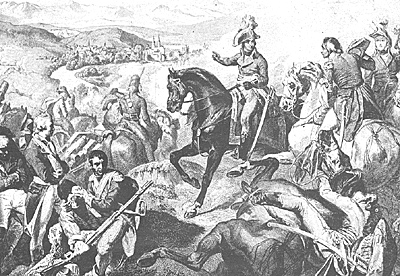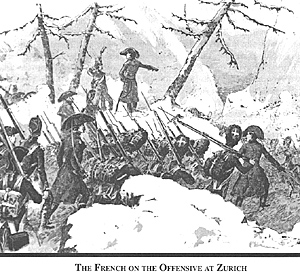 Eyewitnesses to those amazing times did not mince
words. One described the Holy Warriors of the Czar as
"exactly the same hard, stiff wooden machines which we
have reason to figure ourselves as the Russians of the
Seven Years War ... they waddled slowly forward to the tap-tap of their monotonous drums; and if they were beaten
they waddled slowly back again, without appearing in
either case to feel a sense of danger..."
Eyewitnesses to those amazing times did not mince
words. One described the Holy Warriors of the Czar as
"exactly the same hard, stiff wooden machines which we
have reason to figure ourselves as the Russians of the
Seven Years War ... they waddled slowly forward to the tap-tap of their monotonous drums; and if they were beaten
they waddled slowly back again, without appearing in
either case to feel a sense of danger..."
Yet Britain's Military Mentor also noted that "no
troops in the world are so careless of being attacked in the
flank, or turned..." Of the other warring parties Albrecht
Adam wrote in 1797, "I was roused to enthusiasm by the
smart and colorful uniforms of the French Revolutionary
army, the keen spirit, the very soul, the characteristically
wild faces of those soldiers, and their strange way of
moving. The most striking contrast was produced by the
Austrian armies. We saw them pass by, calm and grave,
mostly in serried columns, correctly dressed even in mid-campaign. Resigned to hardship, never forgetting their
discipline, they always made an impression to be
respected." [1]
Whether they knew it or not, these keen observers
had just seen irrefutable proof of one of the most important,
yet most neglected, aspects of the Napoleonic period.
Simply, it was that the French Revolutionary and
Napoleonic Wars were notjust armed conflicts between
opposing governments, they were wars between vastly
different societies as well. This in turn meant that the
soldiers, as well as the generals who commanded them,
produced by these societies varied greatly in appearance
and demeanor to all who saw them.
This betrayed the fact that they often looked at the
very nature of war itself in ways that were totally
incompatible with each other. It was not a case where one
side played by the accepted rules of the game and the other
did not. Rather it was a situation where the set of rules for
one side was completely different to the those used by the
other. Ultimately, it remained an area of armed conflict
where the human factor could still determine the difference
between victory and defeat.
Second, and perhaps of far greater importance, is that
it helps us realize that the Allied generals who fell so hard
under the hammer blows of the French, particularly in the
early career of a young upstart Corsican named Bonaparte,
were not the idiots many have made them out to be. They
were commanders who potentially could have done quite
well in the era of Frederick the Great. They were simply men
who played the game of war with rules far out of date. It
was not their fault, as no one had told them the rules had
changed.
This clash between opposing military values, and the
decisive results it often produced, took many forms during
the wars of the French Revolution. But perhaps no where
can one find a more fascinating example than the lush
mountainous landscape around the picturesque Swiss
fortress of Zurich. The date was 25 September 1799, and a
battle was about to fought and decided largely on pure
human perception, to include the rather innocuous subject
of a person's taste in music.
Alpine Thunder The Battle of Zurich 1799
 Understanding this concept focuses many things
into crystal clear perspective, but two should be of
particular importance to those interested in the period. The
first is that it helps explain exactly why the undisciplined
and poorly trained armies of the French Republic were able
to more than hold their own against their professional
adversaries. While differences in doctrine had much to do
with this, the influence of the human perspective can not be
discounted.
Understanding this concept focuses many things
into crystal clear perspective, but two should be of
particular importance to those interested in the period. The
first is that it helps explain exactly why the undisciplined
and poorly trained armies of the French Republic were able
to more than hold their own against their professional
adversaries. While differences in doctrine had much to do
with this, the influence of the human perspective can not be
discounted.
Introduction
The War of the Second Coalition
The Commanders
Fire in the Mountains
Epilogue
Order of Battle
Jumbo Map of Battle of Zurich: Sep 24-25, 1799 (monstrously slow: 716K)
Back to Empire, Eagles, & Lions Table of Contents Vol. 2 No. 4
Back to EEL List of Issues
Back to MagWeb Master Magazine List
© Copyright 1994 by Emperor's Headquarters
This article appears in MagWeb (Magazine Web) on the Internet World Wide Web.
Other articles from military history and related magazines are available at http://www.magweb.com
